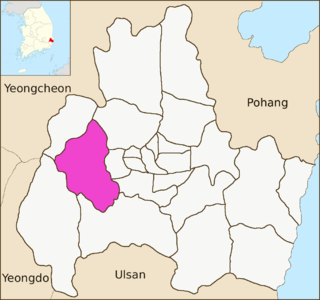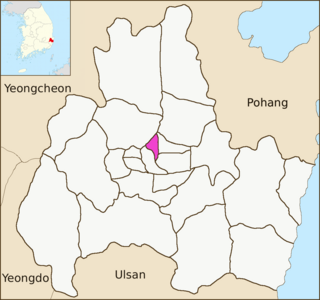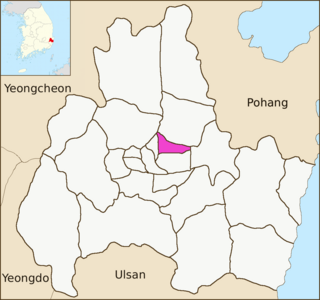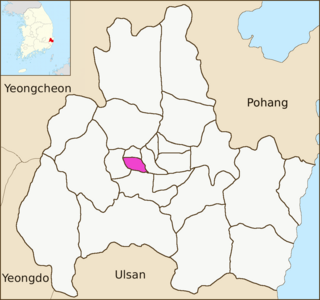The primary subdivisions of Gyeongju in South Korea consist of 4 eup, 8 myeon, and 11 dong. These units are the same into which all of the cities and counties of South Korea are divided. The dong units occupy the area of the city center, which was formerly occupied by Gyeongju-eup. Eup refers to a substantial village, whereas the myeon are more rural. The current divisions are as follows, using the numbers given on the map:

Angang-eup is an eup or a town and is the second-largest subdivision of Gyeongju City. Its 139 square kilometers are home to about 33,300 people, and is served by six elementary schools and two joint middle-high schools. Situated next to Gangdong-myeon in the city's northern tip, it is a significant town in its own right. Angang Station is a regular stop on the Donghae Nambu Line. The town center lies on the Hyeongsan River, near where it meets the small Chilpyeongcheon stream. Important local products include rice, apples, and grapes.

Oedong-eup is an eup or a town in the subdivision of the Gyeongju City, North Gyeongsang province, South Korea. Its 139 square kilometers are home to about 17, 500 people. It is linked by road and rail to the neighboring metropolis of Ulsan. Due to the feature, the town has been a center of the development of Gyeongju's automotive parts industry. Three industrial complexes are located here. This population is served by six elementary schools, a middle school, and a high school

Geoncheon-eup is an eup or a town in the subdivision of the Gyeongju City, North Gyeongsang province, South Korea. Its 90.46 square kilometers are home to about 10,844 people. This population is served by three elementary schools, and one joint middle-high school.

Seo-myeon is a myeon or a township in the subdivision of the Gyeongju City, North Gyeongsang province, South Korea. It is bordered by its neighborhoods including Hyeongok-myeon and Geoncheon-eup on the east, Sannae-myeon on the south and Yeongcheon City on the west and north. Its 52.12 square kilometers are home to about 4,166 people. This population is served by one elementary school and one joint middle school.

Hyeongok-myeon is a myeon or a township in the administrative subdivisions of Gyeongju City, North Gyeongsang province, South Korea. It is bordered by Hyeongsan River, Cheonbuk-myeon and Yonghwang-dong to the east, Bodeok-dong to the south, Geoncheon-eup to the southwest, Seo-myeon to the west and Angang-eup to the north. It has an area of 55.74 square kilometers and is home to 13,658 people. This population is served by three elementary schools, one middle school and one high school.

Cheonbuk-myeon is a myeon or a township in the administrative subdivisions of the Gyeongju City, North Gyeongsang province, South Korea. It is bordered by Pohang city on the east, Bodeok-dong on the south, Angang-eup and Hyeongok-myeon to the boundary Hyeongsan River on the west and Gangdong-myeon on the north. Its 58.15 square kilometers are home to about 6,140 people. This population is served by two elementary schools, one high school.

Yangbuk-myeon is a myeon or a township in the administrative subdivisions of the Gyeongju City, North Gyeongsang province, South Korea. It is bordered by Gampo-eup and Sea of Japan on the east, Yangnam-myeon on the south, Bulguk-dong, Bodeok-dong and Oedong-eup on the west and Ocheon-eup and Janggi-myeon of the Pohang city on the north. Its 120.06 square kilometers are home to about 4,558 people. This population is served by one joint elementary-middle school.

Naenam-myeon is a myeon or a township in the administrative subdivisions of the Gyeongju City, North Gyeongsang province, South Korea. It is bordered by Geumo Mountains on the east, Jusa Mountains on the south. Its 122.05 square kilometers are home to about 6,142 people. This population is served by one elementary school and one high school.

Seonggeon-dong is an administrative dong or a neighbourhood in the administrative subdivisions of the Gyeongju City, North Gyeongsang province, South Korea. It consists of four legal dongs including Seonggeon-dong and Seokjang-dong. It is bordered by Dongcheon-dong on the east, Geoncheon-eup on the west and Jungbu-dong on the south and Hyeongok-myeon on the north. Its 6.42 square kilometers are home to about 18,219 people. The Gyeongju branch campus of Dongguk University is situated in the district and it has an elementary school and a high school

Hwangseong-dong is both an administrative and legal dong or a neighbourhood in the administrative subdivisions of the Gyeongju City, North Gyeongsang province, South Korea. It is bordered by Yonggang-dong on the east, Hyeongok-myeon on the west and north and Seongnae-dong on the south. Its 3.84 square kilometers are home to about 29,140 people. It has two elementary schools, three middle schools and one high school

Yonggang-dong is both an administrative and legal dong or a neighbourhood in the administrative subdivisions of the Gyeongju City, North Gyeongsang province, South Korea. It is bordered by Bukgun-dong on the east, Deoksan-ri of Cheonbuk-myeon on the northeast, Hwangseong-dong and Dongcheon-dong on the south and Geumjang-ri of Hyeongok-myeon on the south. Its 5.06 square kilometers are home to about 15,817 people. It has two elementary schools, a middle school and a high school

Bodeok-dong is an administrative dong or a neighbourhood in the administrative subdivisions of the Gyeongju City, North Gyeongsang province, South Korea. It consists of seven legal dong including Cheongun-dong, Sinpyeong-dong, Bukgun-dong, Sogok-dong, Deok-dong, Hwangnyeong-dong and Amgok-dong

Bulguk-dong is an administrative dong or a neighbourhood in the administrative subdivisions of the Gyeongju City, North Gyeongsang province, South Korea. It consists of seven legal dong including Gujeong-dong, Sirae-dong, Si-dong, Joyang-dong, Jinhyeon-dong, Ma-dong and Ha-dong.
Tapjeong-dong was an administrative dong or a neighbourhood in the administrative subdivisions of the Gyeongju City, North Gyeongsang province, South Korea until January 2009. It consisted of four legal dong including Tap-dong, Sajeong-dong, Yul-dong, and Bae-dong.

Wolseong-dong is an administrative dong or a neighbourhood in the administrative subdivisions of the Gyeongju City, North Gyeongsang province, South Korea. It consists of nine legal dong including Inwang-dong, Gyo-dong, Dongbang-dong, Doji-dong, Namsan-dong, Pyeong-dong, Guhwang-dong, Bomun-dong and Baeban-dong

Dongcheon-dong is both an administrative and legal dong or a neighbourhood of the Gyeongju City, North Gyeongsang province, South Korea. It is bordered by Bodeok-dong on the east, Yonggang-dong and Seongdong-dong on the west, Bohwang-dong on the south and Cheonbuk-myeon on the north. Its 5.26 square kilometers are home to about 26,507 people. After the liberation of Korea, returnees from abroad were numerous; a village for them was constructed in present-day Dongcheon-dong

Hwangnam-dong is a dong or a neighbourhood of the Gyeongju City, North Gyeongsang province, South Korea. It is bordered by Dodong-dong on the east, Tapjeong-dong on the west, Naenam-myeon on the south and Jungang-dong on the north. Its 20.5 square kilometers are home to about 8,885 people. It is both an administrative and legal dong.

Jungbu-dong is a dong or a neighbourhood of the Gyeongju City, North Gyeongsang province, South Korea. It is bordered by Songdong-dong and Hwango-dong on the east, Seonggeon-dong on the west, Hwangnam-dong on the south and Hwangseong-dong on the north. Its 0.93 square kilometers are home to about 6,894 people. It is an administrative dong that consists of five legal dongs such as Seobu-dong, Dongbu-dong, Bukbu-dong, Noseo-dong, and Nodong-dong.

Hwango-dong is a dong or a neighbourhood of the Gyeongju City, North Gyeongsang province, South Korea. It is located in the central Gyeongju and is bordered by Bohwang-dong on the east, Jangang-dong on the west, Hwangnam-dong on the south and Seongdong-dong on the north. Its 1.5 square kilometers are home to about 10225 people. It is both an administrative dong and legal dong.



















